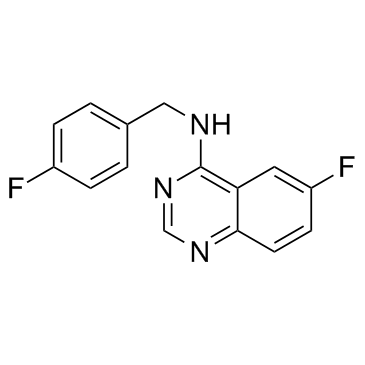1262888-28-7
| Name | spautin-1 |
|---|---|
| Synonyms |
spautin-1, autophagy inhibitor (6-fluoro-n-(4-fluorobenzyl)quinozaline-4-amine)
6-fluoro-n-(4-fluorobenzyl)quinazolin-4-amine 4-Quinazolinamine, 6-fluoro-N-[(4-fluorophenyl)methyl]- 6-Fluoro-N-(4-fluorobenzyl)-4-quinazolinamine Spautin 1 |
| Description | Spautin-1 is a specific and potent autophagy inhibitor-1. |
|---|---|
| Related Catalog | |
| In Vitro | Spautin-1 enhances imatinib mesylate (IM)-induced CmL cell apoptosis by reducing the expression of the anti-apoptotic proteins Mcl-1 and Bcl-2. The pro-apoptotic activity of spautin-1 is associated with activation of GSK3β, an important downstream effector of PI3K/AKT. Spautin-1 enhances IM-induced cytotoxicity in CmL cell line K562, decreasing the IC50 from 1 to 0.5 μM[1]. The mechanism of spautin-1 acting on acute pancreatitis is associated with impaired autophagy inhibition[2]. |
| In Vivo | Spautin-1 ameliorates the pathogenesis of acute pancreatitis induced by cerulein or L-arginine. Spautin-1 pretreatment significantly diminishes the elevation of serum amylase and lipase levels, which are indicative of trypsin activity. Increasing levels of serum TNFα caused by cerulein are inhibited in the presence of spautin-1. Spautin-1 treatment can ameliorate the inflammation damage induced by cerulein, such as edema, degeneration, coagulative necrosis and infiltration of inflammatory cells[2]. |
| Cell Assay | Spautin-1 is dissolved in DMSO. Cell proliferation is evaluated using CCK-8 kit. K562 cells (1x105/mL) are seeded into 96-well plates in triplicate and then treated with 125 to 4,000 nM IM alone or in combi¬nation with spautin-1 (10 μM). After 48 h of incubation, 10 μL of CCK-8 reagent is added to each well. Four hours later, the absorbance is read at 450 nm using a microplate reader[1]. |
| Animal Admin | Mice: In this study, mice models with acute pancreatitis, including cerulein- and L-arginine-induced models, are constructed. For the cerulein-induced model, four intraperitoneal injections of cerulein (50 μg/kg body weight) are given consecutively at hourly intervals; The L-arginine-induced model received hourly intraperitoneal injections of 1.4 g/kg (optimal dosage for this study) L-arginine three times[2]. |
| References |
| Density | 1.4±0.1 g/cm3 |
|---|---|
| Boiling Point | 419.6±40.0 °C at 760 mmHg |
| Molecular Formula | C15H11F2N3 |
| Molecular Weight | 271.265 |
| Flash Point | 207.6±27.3 °C |
| Exact Mass | 271.092102 |
| PSA | 37.81000 |
| LogP | 3.40 |
| Vapour Pressure | 0.0±1.0 mmHg at 25°C |
| Index of Refraction | 1.672 |
| Symbol |


GHS05, GHS07 |
|---|---|
| Signal Word | Danger |
| Hazard Statements | H302-H318 |
| Precautionary Statements | P280-P305 + P351 + P338 |
| Hazard Codes | Xi |
| Risk Phrases | 22-41 |
| Safety Phrases | 26-39 |
| RIDADR | NONH for all modes of transport |
| HS Code | 2933990090 |
| HS Code | 2933990090 |
|---|---|
| Summary | 2933990090. heterocyclic compounds with nitrogen hetero-atom(s) only. VAT:17.0%. Tax rebate rate:13.0%. . MFN tariff:6.5%. General tariff:20.0% |
